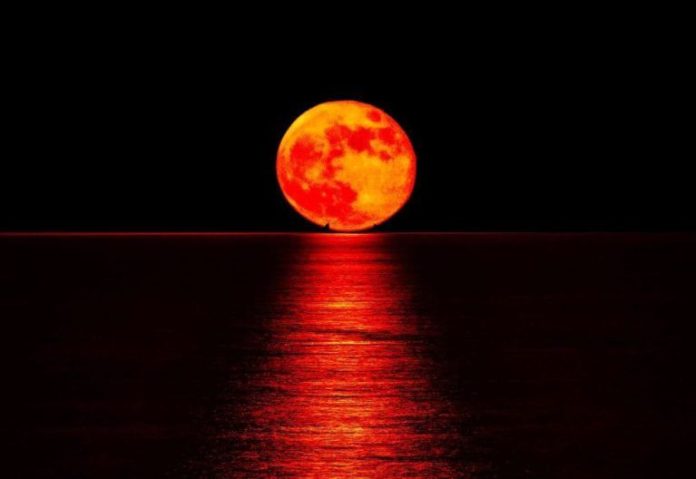On the night of September 7–8, 2025, much of Africa experienced a rare and striking astronomical event: a total lunar eclipse, widely called a “Blood Moon.” For just over 80 minutes, Earth’s shadow completely covered the Moon, turning it a deep copper-red. According to ‘Time and Date’ site, around 85 percent of the global population was in a position to view at least part of the eclipse, with the clearest visibility in eastern and southern Africa, Europe, Asia and western Australia.
A lunar eclipse takes place when Earth moves directly between the Sun and the Moon, blocking sunlight from striking the lunar surface. What makes the eclipse so visually distinctive is not simply the shadow itself, but the color it produces. As NASA explains, light traveling through Earth’s atmosphere is filtered and refracted: shorter blue wavelengths scatter away, while the longer red wavelengths bend into Earth’s shadow and project onto the Moon. The precise shade seen depends on the atmosphere’s condition at the time. Dust, smoke or volcanic ash can darken the hue, while clearer skies tend to produce a softer, orange tone.
Unlike solar eclipses, lunar eclipses can be observed safely with the naked eye. No special protection is required, making them among the most accessible astronomical phenomena. Binoculars or a telescope can enhance detail, but for most observers across Africa, the view required only patience and a sky free of bright city lights. Space.com and LiveScience noted that this ease of viewing, combined with the eclipse’s length and wide reach, turned it into a global teaching moment, drawing large public audiences to astronomy.
Read also: Remarkable not remakeable, inside African Originals’ sustainability journey
In African cultural contexts, eclipses have often carried layered meanings. Some traditions treat the reddened Moon as an omen, while others see it as a moment of reflection or spiritual observation. Modern audiences, however, often balance cultural interpretation with scientific explanation. Regional reporting after the September eclipse highlighted how communities gathered to watch together, while others turned to livestreams and digital galleries when cloud cover obstructed the view. This combination of local experience and global digital connection underscores how astronomical events today resonate simultaneously at community and international levels.
Among African communities like the Samburu of northern Kenya, a lunar eclipse is interpreted as an unfavorable period. Festivities and community celebrations are suspended until the second lunar cycle passes, signaling the restoration of cosmic balance. For the Maasai of East Africa, the eclipse reflects a struggle in the heavens, as though a spirit has swallowed the Moon. Communities respond with loud chants and calls, demanding that the spirit release it and restore the night sky. Along Kenya’s coast, different tribes hold that an eclipse foreshadows misfortune; during such nights, cooking and childbirth are forbidden, and ritual cleansing is required to protect households from lingering harm.
Further west, traditions take on a different tone. In Nigeria, the Yoruba imagine eclipses as quarrels between cosmic siblings. To mend the rift, offerings and prayers are made, an effort to restore harmony between the forces that govern the heavens. In Mali, the Bambara and Dogon interpret eclipses as thresholds that connect the living with the ancestral world. For them, the darkened Moon opens a channel through which guidance and prophecy may be offered by those who came before. These diverse interpretations highlight the way astronomical events intertwine with social order, spirituality, and daily life.
Modern science provides a contrasting, but complementary, perspective. Contrary to long-held myths, lunar eclipses pose no danger to viewers. Unlike solar eclipses, no protective glasses are needed, as the dimmed Moon is perfectly safe to observe with the naked eye. The Kenya Space Agency and other scientific bodies encourage viewing with curiosity, noting that binoculars or a telescope may enhance detail but are not required to appreciate the sight.
Read also: WRI report launched at AFS Forum 2025 exposes billions lost to food waste in Kenya
The phase of totality, the period when the Moon was fully in Earth’s shadow, lasted roughly 82 minutes, making it one of the longer eclipses in recent memory. Such durations depend on the Moon’s orbital position: when it passes through the center of Earth’s shadow, totality lasts longer; when it crosses closer to the edge, the period is shorter. This eclipse offered researchers and amateur astronomers alike a valuable opportunity to observe atmospheric effects, subtle changes in lunar brightness, and even the way local weather and pollution influenced the Moon’s visible color.
From the lunar surface itself, the view would be even more dramatic. Standing on the Moon during an eclipse, one would not see it darken. Instead, Earth would slide across the face of the Sun, casting an immense shadow. Around Earth’s rim, the glow of every sunrise and sunset on the planet would form a fiery red halo, the same light that paints the Moon’s surface for observers back on Earth.
For scientists, eclipses are more than spectacles. They act as natural laboratories for studying Earth’s atmosphere. During totality, the only sunlight that reaches the Moon has traveled through Earth’s atmospheric layers, carrying signatures of gases and particles. By analyzing this refracted light, researchers can measure atmospheric composition and even detect pollutants, contributing to improved climate models. Lunar eclipses also enhance surface visibility, allowing astronomers to map features that are otherwise hidden by bright sunlight. Historically, eclipses provided ancient civilizations with critical tools for tracking time, leading to refinements in calendars and the recognition of the Saros cycle, an 18-year, 11-day pattern of recurring eclipses still used in astronomy today.
Looking ahead, eclipses follow predictable cycles. The next total lunar eclipse will occur on March 2–3, 2026, and will be more favorable for viewers in North America and the Pacific. For Africa, partial eclipses and penumbral events will remain visible in the intervening years, though none will match the dramatic visual impact of this September’s Blood Moon. With reference to NASA and the European Space Agency, such events are part of a broader cycle of celestial mechanics that can be calculated decades in advance, reminding us that the rhythms of the sky remain both predictable and profound.
What sets the Blood Moon apart is how it bridges scientific fact and lived experience. Scientifically, it is a simple alignment of Sun, Earth and Moon, governed by orbital geometry. Yet the red light cast on the lunar surface is a reflection of Earth’s own atmosphere. In a literal sense, the Moon’s changing face during an eclipse carries the imprint of our planet’s air, shaped by natural conditions and, increasingly, by human activity. For many who watched across Africa and beyond, the eclipse was not just a spectacle but a reminder that the systems shaping our night sky are also linked to the state of our shared environment.
Read also: Intra-African Trade Fair 2025 opens in Algiers with $44 billion in deals projected






